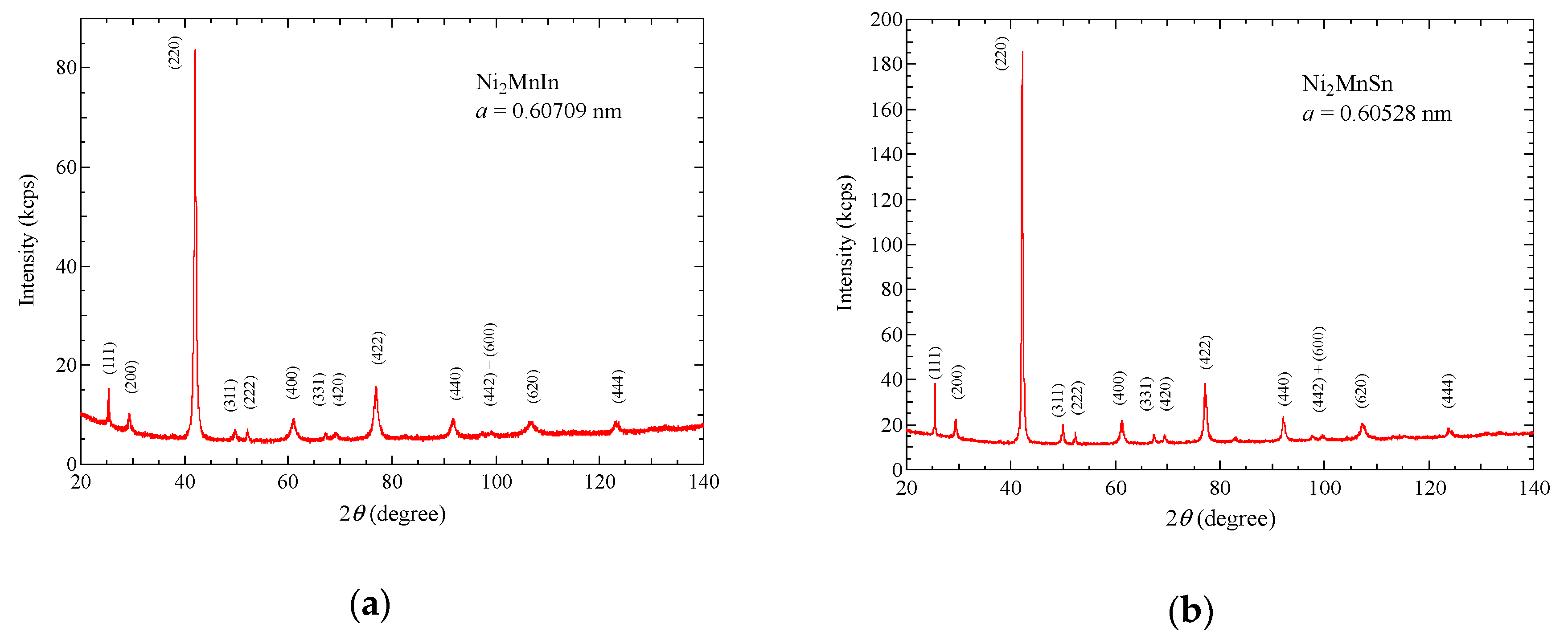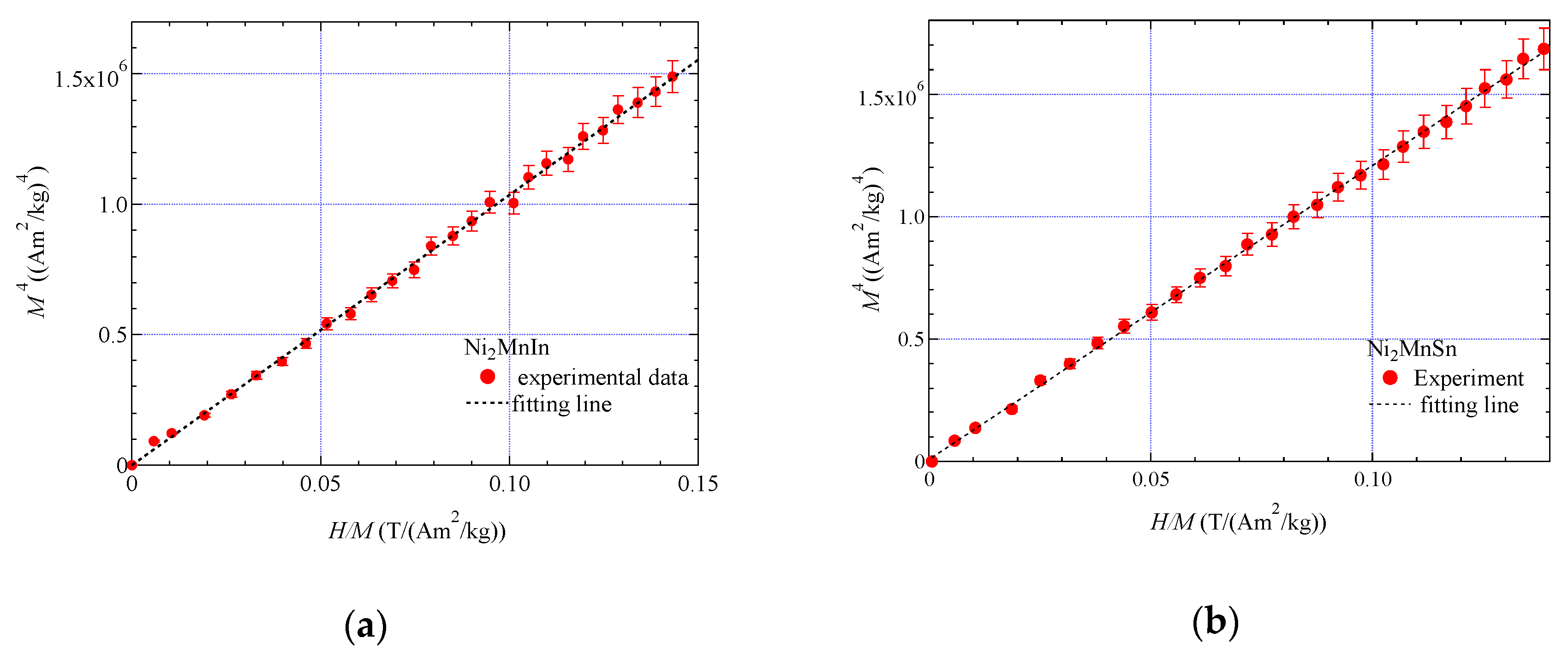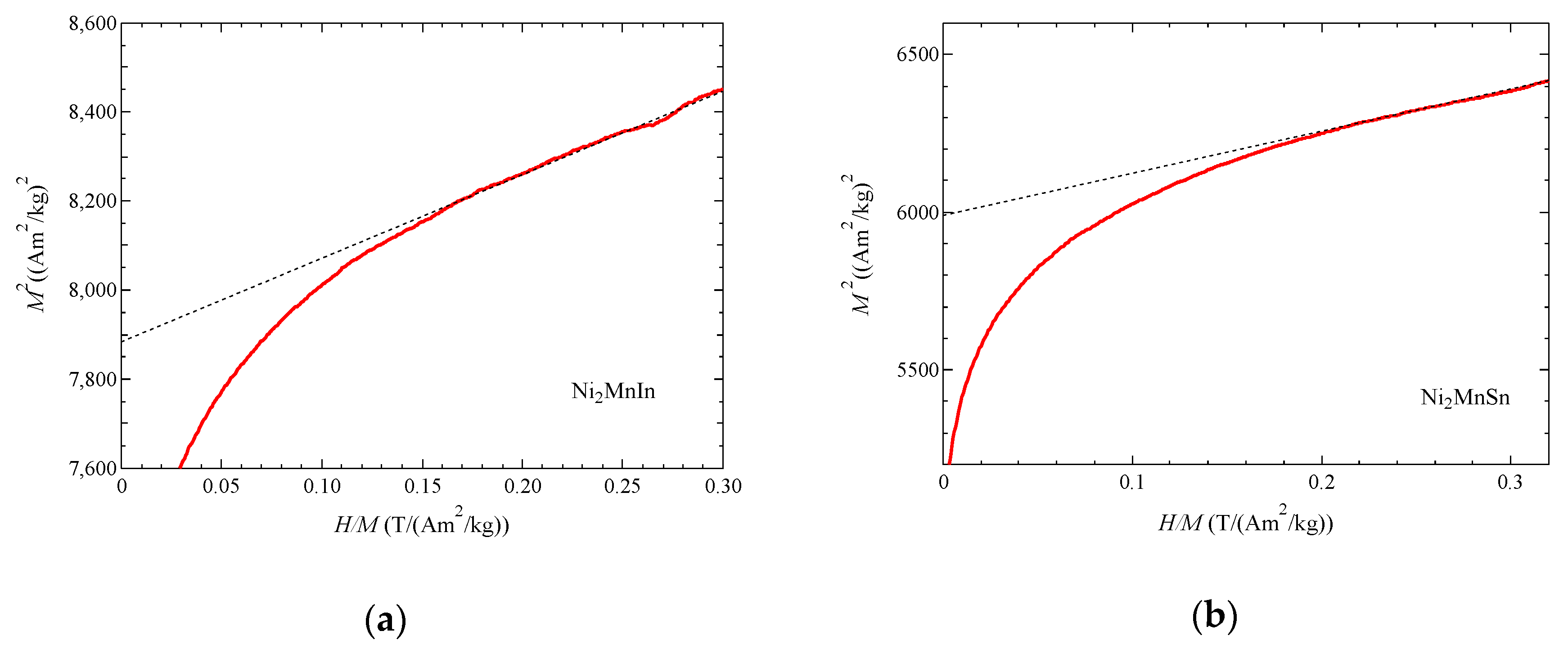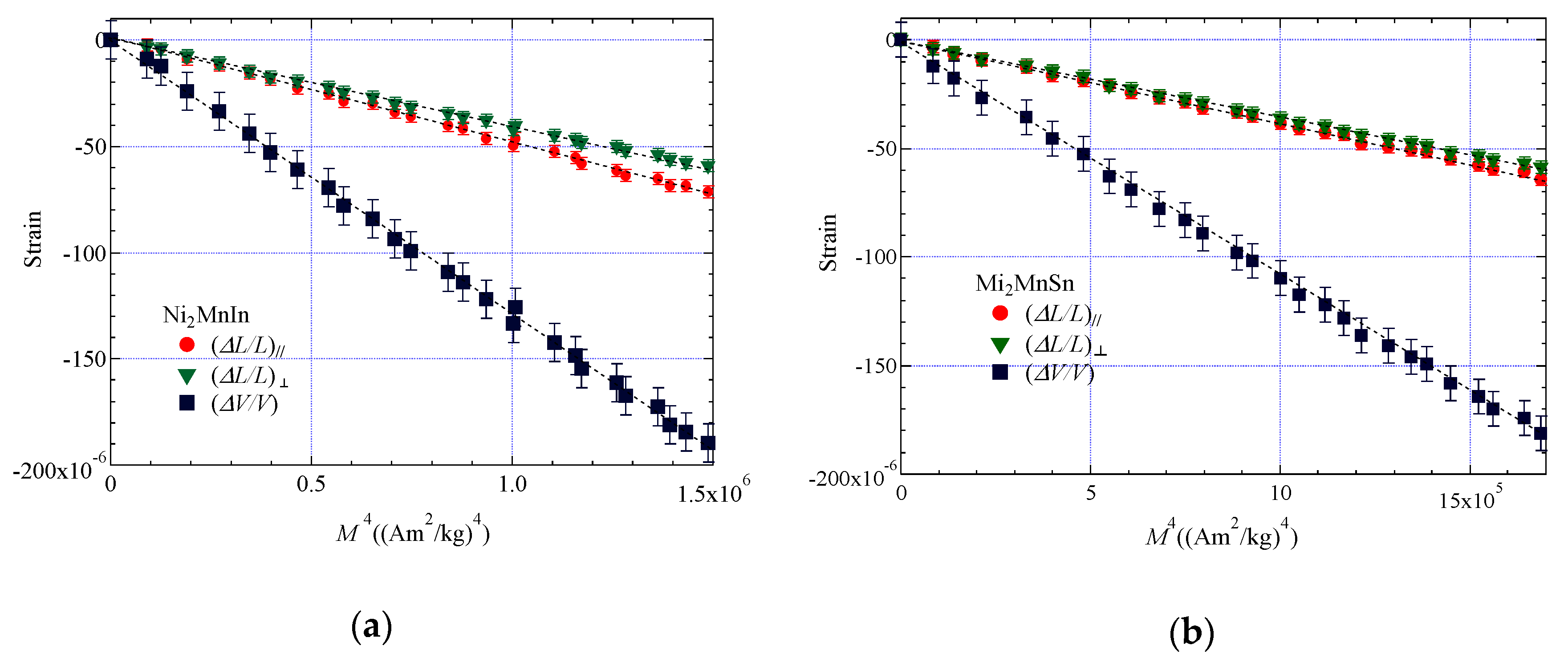The Forced Magnetostrictions and Magnetic Properties of Ni2MnX (X = In, Sn) Ferromagnetic Heusler Alloys
Abstract
1. Introduction
2. Materials and Methods
3. Results and Discussion
3.1. Magnetic Field Dependence of Magnetization
3.2. Correlation between Magnetization and Forced Magnetostriction
3.3. Spin Polarization of Ni2MnGa-Type Heusler Alloys
4. Conclusions
Author Contributions
Funding
Acknowledgments
Conflicts of Interest
References
- Takahashi, Y. Spin Fluctuation Theory of Itinerant Electron Magnetism; Springer: Berlin, Germany, 2013; ISBN 978-3-642-36666-6. [Google Scholar]
- Takahashi, Y. On the origin of the Curie Weiss law of the magnetic susceptibility in itinerant electron ferromagnetism. J. Phys. Soc. Jpn. 1986, 55, 3553–3573. [Google Scholar] [CrossRef]
- Takahashi, Y. Theoretical Development in Itinerant Electron Ferromagnetism. J. Phys. Conf. Ser. 2017, 868, 012002. [Google Scholar] [CrossRef]
- Takahashi, Y.; Nakano, H. Magnetovolume effect of itinerant electron ferromagnets. J. Phys. Cond. Matter. 2006, 18, 521. [Google Scholar] [CrossRef]
- Moriya, T. Spin Fluctuations in Itinerant Electron Magnetism; Springer: Berlin, Germany, 1985; ISBN 978-3-642-82499-9. [Google Scholar]
- Moriya, T.; Kawabata, A. Effect of Spin Fluctuations on Itinerant Electron Ferromagnetism. J. Phys. Soc. Jpn. 1973, 34, 639–651. [Google Scholar] [CrossRef]
- Moriya, T.; Kawabata, A. Effect of Spin Fluctuations on Itinerant Electron Ferromagnetism. II. J. Phys. Soc. Jpn. 1973, 35, 669–676. [Google Scholar] [CrossRef]
- Matsunaga, M.; Ishikawa, Y.; Nakajima, T. Magneto-volume effect in the weak itinerant ferromagnet MnSi. J. Phys. Soc. Jpn. 1982, 51, 1153. [Google Scholar] [CrossRef]
- Rizal, C.; Kolthammer, J.; Pokharel, R.K.; Choi, B.C. Magnetic properties of nanostructured Fe-Co alloys. J. Appl. Phys. 2013, 113, 113905. [Google Scholar] [CrossRef]
- Nishihara, H.; Harada, T.; Kanomata, T.; Wada, T. Magnetization process near the Curie temperature of an itinerant ferromagnet CoS2. J. Phys. Conf. Ser. 2012, 400, 032068. [Google Scholar] [CrossRef]
- Nishihara, H.; Komiyama, K.; Oguro, I.; Kanomata, T.; Chernenko, V. Magnetization processes near the Curie temperatures of the itinerant ferromagnets, Ni2MnGa and pure nickel. J. Alloys Compd. 2007, 442, 191–193. [Google Scholar] [CrossRef]
- Faske, T.; Radulov, L.A.; Hölzel, M.; Gutfleisch, O.; Donner, W. Direct Observation of Paramagnetic Spin Fluctuations in LaFe13−xSix. J. Phys. Condens. Matter. 2020, 32, 115802. [Google Scholar] [CrossRef]
- Tateiwa, N.; Pospíšil, J.; Haga, Y.; Sakai, H.; Matsuda, T.D.; Yamamoto, E. Itinerant ferromagnetism in actinide 5f-electron systems: Phenomenological analysis with spin fluctuation theory. Phys. Rev. B 2017, 96, 035125. [Google Scholar] [CrossRef]
- Sakon, T.; Hayashi, Y.; Fujimoto, N.; Kanomata, T.; Nojiri, H.; Adachi, Y. Forced magnetostriction of ferromagnetic Heusler alloy Ni2MnGa at the Curie temperature. J. Appl. Phys. 2018, 123, 213902. [Google Scholar] [CrossRef]
- Sakon, T.; Hayashi, Y.; Li, D.X.; Honda, F.; Oomi, G.; Narumi, Y.; Hagiwara, M.; Kanomata, T.; Eto, T. Forced Magnetostrictions and Magnetizations of Ni2+xMnGa1−x at Its Curie Temperature. Materials 2018, 11, 2115. [Google Scholar] [CrossRef] [PubMed]
- Sakon, T.; Hayashi, Y.; Fukuya, A.; Li, D.; Honda, F.; Umetsu, R.Y.; Xu, X.; Oomi, G.; Kanomata, T.; Eto, T. Investigation of the Itinerant Electron Ferromagnetism of Ni2+xMnGa1−x and Co2VGa Heusler Alloys. Materials 2019, 12, 575. [Google Scholar] [CrossRef] [PubMed]
- Sakon, T.; Yamasaki, Y.; Kodama, H.; Kanomata, T.; Nojiri, H.; Adachi, Y. The Characteristic Properties of Magnetostriction and Magneto-Volume Effects of Ni2MnGa-Type Ferromagnetic Heusler Alloys. Materials 2019, 12, 3655. [Google Scholar] [CrossRef]
- Kittel, C. Introduction of Solid State Physics, 8th ed.; John Wiley & Sons Inc.: Hoboken, NJ, USA, 2004; p. 75. ISBN 978-0-471-41526-8. [Google Scholar]
- Nizhankovskii, V.I. Classical magnetostriction of nickel in high magnetic field. Eur. Phys. J. B 2006, 53, 1–4. [Google Scholar] [CrossRef]
- Kanomata, T.; Shirakawa, K.; Kaneko, T. Effect of Hydrostatic Pressure on the Curie Temperature of the Heusler alloys Ni2MnZ (Z = AI, Ga, In, Sn AND Sb). J. Magn. Magn. Mater. 1987, 65, 76–82. [Google Scholar] [CrossRef]
- Sakon, T.; Fujimoto, N.; Kanomata, T.; Adachi, Y. Magnetostriction of Ni2Mn1−xCrxGa Heusler Alloys. Metals 2017, 7, 410. [Google Scholar] [CrossRef]
- Arrott, A.; Noakes, J.E. Approximate equation of the state for Nickel near its Critical Temperature. Phys. Rev. Lett. 1967, 19, 786–789. [Google Scholar] [CrossRef]
- Webster, P.J. Heusler alloys. Contemp. Phys. 1969, 10, 559–577. [Google Scholar] [CrossRef]
- Qawasmeh, Y.; Hamad, B. Investigation of the structural, electronic, and magnetic properties of Ni based Heusler alloys from first principles. J. Appl. Phys. 2012, 111, 033905. [Google Scholar] [CrossRef]
- Jezierski, A. Electronic structure, magnetic, optical and thermodynamic properties of Ni2Mn1−xRexSn and NiMn1−xRexSn Heusler alloys—Ab-initio study. J. Alloys Compds. 2019, 803, 153e164. [Google Scholar] [CrossRef]
- Bocklage, L.; Scholtyssek, J.M.; Merkt, U.; Meier, G. Spin polarization of Ni2MnIn and Ni80Fe20 determined by point-contact Andreev spectroscopy. J. Appl. Phys. 2017, 101, 09J512. [Google Scholar] [CrossRef]
- Umetsu, R.Y.; Kobayashi, K.; Fijita, A.; Kainuma, R.; Ishida, K.; Fukamichi, K.; Sakuma, A. Magnetic properties, phase stability, electric structure, and half-metallicity of L21-type Co2 (V1−xMnx)Ga Heusler alloys. Phys. Rev. B 2008, 77, 104422. [Google Scholar] [CrossRef]
- Singh, S.; Bednarcik, J.; Barman, S.R.; Felsher, S.R.; Pandey, D. Premartensite to martensite transition and its implications for the origin of modulation in Ni2MnGa ferromagnetic shape-memory alloy. Phys. Rev. B 2015, 92, 054412. [Google Scholar] [CrossRef]
- Webster, P.J.; Ziebeck, K.R.A.; Town, S.L.; Peak, M.S. Magnetic order and phase transition in Ni2MnGa. Philos. Mag. B 1984, 49, 295–310. [Google Scholar] [CrossRef]





| Alloy | ps (μB/f. u.) | peff (μB/f. u.) | TC (K) | TA (K) | T0 (K) | km | Reference |
|---|---|---|---|---|---|---|---|
| Ni2MnGa | 3.93 | 4.75 | 375 | 563 | 245 | 1.61 | [15] T = TC |
| Ni2MnGa | 3.93 | 4.75 | 375 | 556 | 254 | 1.57 | [15] T = 5 K |
| Ni2MnIn | 4.40 1 | 4.69 2 | 314 | 351 | 255 | 1.23 | This work TC |
| Ni2MnIn | 4.40 1 | 4.69 2 | 314 | 332 | 296 | 1.11 | This work 4.2 K |
| Ni2MnSn | 4.05 1 | 5.00 2 | 337 | 461 | 271 | 1.42 | This work TC |
| Ni2MnSn | 4.05 1 | 5.00 2 | 337 | 432 | 286 | 1.37 | This work 4.2 K |
| Alloy | ΔV/V at 5 T | M4 ((Am2/kg)4) at 5 T | Bulk Modulus K (GPa) | K·(ΔV/V) (J/m3) |
|---|---|---|---|---|
| Ni2MnGa | 152 10−6 1 | 1.52 106 1 | 166 2 | 2.52 10−2 |
| Ni2MnIn | 190 10−6 | 1.49 106 | 137 2 | 10−2 |
| Ni2MnSn | 182 10−6 | 1.69 106 | 143 3 | 10−2 |
| Sample | TC (K) | pS (μB/f.u.) | peff (μB/f.u.) | pC (μB/f.u.) | pC/pS | Reference |
|---|---|---|---|---|---|---|
| Ni2MnGa | 375 | 3.93 | 4.75 | 3.85 | 0.980 | [16,20] |
| Ni2MnIn | 314 * | 4.4 | 4.69 | 3.78 | 0.860 | * This work, [20] |
| Ni2MnSn | 337 * | 4.05 | 5.00 | 4.10 | 1.01 | * This work, [20] |
© 2020 by the authors. Licensee MDPI, Basel, Switzerland. This article is an open access article distributed under the terms and conditions of the Creative Commons Attribution (CC BY) license (http://creativecommons.org/licenses/by/4.0/).
Share and Cite
Sakon, T.; Yamazaki, J.; Komori, T.; Kanomata, T.; Narumi, Y.; Hagiwara, M.; Nojiri, H.; Adachi, Y. The Forced Magnetostrictions and Magnetic Properties of Ni2MnX (X = In, Sn) Ferromagnetic Heusler Alloys. Materials 2020, 13, 2017. https://doi.org/10.3390/ma13092017
Sakon T, Yamazaki J, Komori T, Kanomata T, Narumi Y, Hagiwara M, Nojiri H, Adachi Y. The Forced Magnetostrictions and Magnetic Properties of Ni2MnX (X = In, Sn) Ferromagnetic Heusler Alloys. Materials. 2020; 13(9):2017. https://doi.org/10.3390/ma13092017
Chicago/Turabian StyleSakon, Takuo, Junya Yamazaki, Takumi Komori, Takeshi Kanomata, Yasuo Narumi, Masayuki Hagiwara, Hiroyuki Nojiri, and Yoshiya Adachi. 2020. "The Forced Magnetostrictions and Magnetic Properties of Ni2MnX (X = In, Sn) Ferromagnetic Heusler Alloys" Materials 13, no. 9: 2017. https://doi.org/10.3390/ma13092017
APA StyleSakon, T., Yamazaki, J., Komori, T., Kanomata, T., Narumi, Y., Hagiwara, M., Nojiri, H., & Adachi, Y. (2020). The Forced Magnetostrictions and Magnetic Properties of Ni2MnX (X = In, Sn) Ferromagnetic Heusler Alloys. Materials, 13(9), 2017. https://doi.org/10.3390/ma13092017





